MITRE ATT&CK® Framework BEGINNERS GUIDE
This guide is designed for you to get a comprehensive understanding of The MITRE ATT&CK Framework and
explore how you can utilize it for your organization.
1.Introduction
The famous criminologist Edmond Locard’s ‘Every contact leaves a trace’ principle also applies to cybercrime. As with any crime, adversaries leave traces behind during cyberattacks and each trace is referred to as an Indicator of Compromise (IoC). An IoC is an evidence that a cyberattack has taken place.
Indicators of Compromise give valuable information about what has happened, prepare defenders for future attacks, and help prevent, detect and respond to similar attacks. However, there are various types of indicators which do not have the same importance, with some being much more valuable than others. Therefore, the differences between indicators have led to the need for a classification system.
A well-known IOC classification, The Pyramid of Pain, was introduced in 2013 by cybersecurity expert David J Bianco. Bianco illustrated the value of each indicator type in this pyramid. He named the pyramid ‘The Pyramid of Pain’ due to the fact that each level is proportional to the pain both security professionals and adversaries feel.
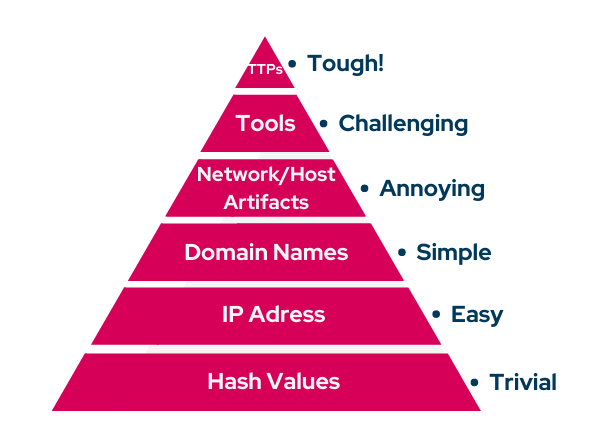
The Pyramid of Pain (David Bianco, 2013)
As we climb to the upper levels of the pyramid, it becomes increasingly difficult (painful) for security professionals to collect and apply indicators. However, it also becomes difficult for adversaries to replace them with new ones. For example, according to a security professional's point of view, it is easy to obtain and incorporate the hash values of malicious files into security controls, but it isn't easy to define and apply TTPs (Tactic, Technique, and Procedures) into security tools. From an adversary's perspective, changing the hash value of a malware file is very simple, however, it is challenging and costly to change TTPs. According to the defender's and adversary's perspectives, each indicator type is given in Appendix A.
Starting with the first antivirus software, we traditionally detect atomic IOCs, such as hash values, IP addresses, and domain names. However, we must also begin to detect adversary behavior, tactics, techniques, and procedures (TTPs), and tools used by adversaries. At least, we have to detect their artifacts in the network and hosts.
Advance Your Cybersecurity Skills with Purple Academy
Enroll in the FREE 1-Hour online course: "The Absolute Beginners Guide to MITRE ATT&CK" on Purple Academy.
2.The MITRE ATT&CK Framework
The MITRE ATT&CK Framework systematically defines and organizes TTPs (tactics, techniques, and procedures). It is a globally accessible public knowledge base in accordance with real-world observations of adversary operations. It has become a common language between security teams to describe TTPs.
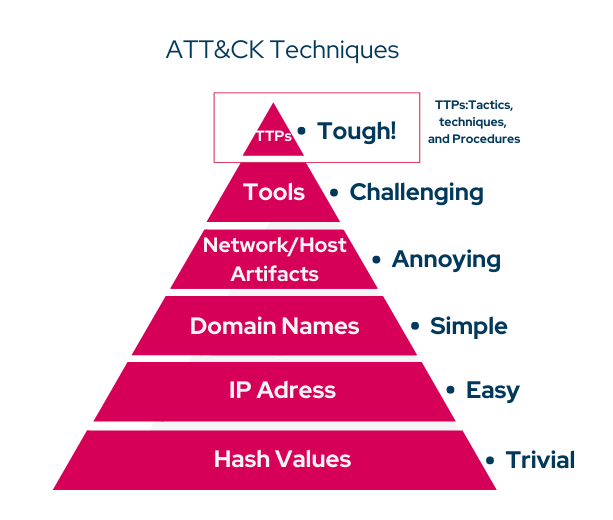
The other important aspect of MITRE ATT&CK is that it is a community-driven initiative; therefore, it is a compelling framework as the whole global security community can contribute to it.
-
The ATT&CK Framework includes observed (known) adversary behavior, so it cannot be expected to consist of every adversary behavior.
2.1. ATT&CK Matrix for Enterprise
-1.png)
This is the MITRE ATT&CK Matrix for Enterpris . In this matrix, each column represents a tactic, the adversary's technical goals. To achieve these goals, in other words, tactics, adversaries use different methods, and these methods are called techniques. So, for example, for Initial Access, an attacker may send a spearphishing attachment or exploit a public-facing application, such as an Apache Server.
There are two other ATT&CK matrices; the Mobile and Industrial Control Systems (ICS) matrices.
MITRE ATT&CK is not static. For example, in the April 2022 v11.3 release, two new techniques and ten new sub-techniques have been added to the Enterprise matrix, and 144 techniques and sub-techniques updated. So, the framework expands as new techniques and tactics are observed and existing (sub-)techniques are updated. In the latest release (v11.3), ATT&CK for Enterprise contains 14 tactics, 191 techniques, and 385 sub-techniques. MITRE ATT&CK also provides threat groups that are related to an intrusion activity and software utilized by these threat groups. MITRE ATT&CK uses the term software to define malware, custom or commercial tools, open-source software, and OS utilities that adversaries use. Currently, ATT&CK includes 133 groups and 680 software.

The above figure presents relationships between objects in the MITRE ATT&CK Framework. We explain these objects in the following sections.
2.2. Tactics
Tactics represent the “what” and “why” of an ATT&CK (sub-)technique and answer the following question: “What goals are adversaries trying to achieve?“. So, they are the adversary’s technical goals, the reason for performing an action, and what they are trying to achieve. For example, an adversary may want to achieve Credential Access in order to gain access to a target network. In addition, each tactic contains a list of techniques that have been observed being used in the wild by threat actors.
The ATT&CK framework is not meant to be read in a linear fashion
An adversary does not have to progress through the tactics from left to right.
An adversary does not have to employ all of the ATT&CK tactics.
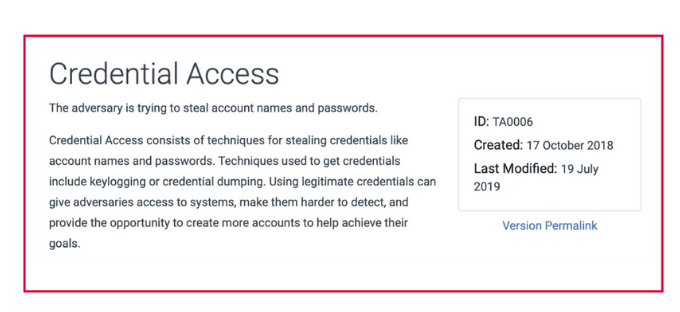
Each tactic has an ID. For example, the ID of the Credential Access tactic is TA0006. MITRE ATT&CK also provides a brief description of each tactic.
The following table represents 14 tactics in the ATT&CK for Enterprise and their brief descriptions.
| ID | Tactic | Goal (The adversary is trying to) |
| TA0043 | Reconnaissance | Collect data to plan future malicious activities. |
| TA0042 | Resource Development | Identify resources to support malicious operations |
| TA0001 | Initial Access | Gain first access to your network |
| TA0002 | Execution | Execute malicious code |
| TA0003 | Persistance | Maintain their foothold |
| TA0004 | Privilege Escalation | Get access to higher-level permissions |
| TA0005 | Defense Evasion | Evade defenses to avoid being detected |
| TA0006 | Credential Access | Acquire account names and passwords |
| TA0007 | Discovery | Investigate your environment |
| TA0008 | Lateral Movement | Move through your environment |
| TA0009 | Collection | Collect data relevant to their goal |
| TA0011 | Command and Control | Control compromised systems and communicate with them |
| TA0010 | Exfiltration | Steal collected data |
| TA0040 | Impact | Alter, corrupt, or destroy your systems and data |
-
The MITRE ATT&CK for Mobile matrix includes 14 tactics, but it does not include “Reconnaissance” and “Resource Development” tactics, but it includes “Network Effects” and “Remote Service Effects” tactics in addition. Note that, these additional tactics have not any technique at the moment.
-
The ATT&CK for ICS (Industrial Control Systems) matrix consists of 12 tactics. It includes tactics of the Enterprise framework except “Reconnaissance”, “Resource Development”, “Credential Access”, and “Exfiltration” tactics. But, the ICS matrix consists of “Inhibit Response Function” and “Impair Process Control” tactics in addition.
2.3. Techniques
Techniques describe “how” an adversary accomplishes a tactical goal through an action or a series of actions. For example, an attacker may utilize the OS Credential Dumping technique to achieve the Credential Access goal (tactic). So, a technique is a specific adversary behavior used to accomplish a goal.
-
Adversaries use many techniques to achieve their overall mission.
-
A technique can be used to achieve multiple goals. So, a technique can be categorized under multiple tactics. For example, the T1078 Valid Accounts technique is categorized under the following four tactics: Defense Evasion, Persistence, Privilege Escalation, Initial Access.
MITRE ATT&CK provides the folowing information about each technique
- Metadata
- Description
- Sub-techniques
- Procedure examples
- Mitigations
- Detections
2.3.1. Metadata
This is the metadata section of the OS Credential Dumping technique, which includes:

ID: Unique identifier of the technique (T1003).
Sub-techniques: IDs of sub-techniques of the technique. OS Credential Dumping technique includes eight sub-techniques identified by T1003.001, T1003.002, …, T1003.008. A sub-technique is a way to describe a specific implementation of a technique in more detail. Note that some techniques do not have sub-techniques, for example, the T1190 Exploit Public-Facing Application technique.
Sub-technique of: Only sub-techniques include this field to define the relevant covering.
Tactics: Name of the technique(s), which the technique is categorized. For example, the tactic of the OS Credential Dumping technique is Credential Access, so adversaries use this technique to achieve Credential Access.
Platforms: This part defines platforms affected by the technique. OS Credential Dumping affects Linux, Windows, and macOS. The MITRE ATT&CK Matrix for Enterprise includes the following platforms: Windows, macOS, Linux, PRE, Cloud (Azure AD, Office 365, Google Workspace, SaaS, IaaS), Network, and Containers.
Permission Required: Some techniques require additional privileges to be applied. For example, the OS Credential Dumping technique requires Administrator or SYSTEM privileges for Windows systems and root permissions for Linux and macOS platforms. Some techniques do not include this field.
Data Sources: ATT&CK defines data sources as “information collected by a sensor or logging system that may be used to collect information relevant to identifying the action being performed, sequence of actions, or the results of those actions by an adversary”. This year, a new concept is added to data sources, which is data components. They bring an additional sub-layer of context to data sources and narrow the identification of security events. For example, “Active Directory: Active Directory Object Access” means that the data source is “Active Directory” and the data component is “Directory Object Access”. Currently, MITRE ATT&CK consists of 33 data sources and 116 data components.

Defense Bypassed: If a technique or sub-technique bypasses or evades a defensive security control, this field exists in the metadata. For example, Process Injection, which is the most used Defense Evasion technique, bypasses Anti-virus and Application Control. However, since OS Credential Dumping is not a Defense Evasion technique, it does not include this field.
Impact Type: This field defines if the technique or sub-technique can be used for “availability” or “integrity” attacks. Note that only the (sub-)techniques categorized under the Impact tactic consist of this field.
CAPEC ID: The Common Attack Pattern Enumeration and Classification (CAPEC) "is a comprehensive dictionary and classification taxonomy of known attacks that can be used by analysts, developers, testers, and educators to advance community understanding and enhance defenses". This metadata field provides CAPEC ID associated with the technique. For example, CAPEC ID is CAPEC-640 for the Process Injection, which is “Inclusion of Code in Existing Process”. Some techniques do not include the CAPEC ID field.
Other metadata fields are Contributors (contributing persons or organizations), Version (the version number of the technique), Created (the first added date to ATT&CK), and Last Modified.
2.3.2. Description

The first part of each technique or sub-technique provides a description. In some techniques, these definitions are written in great detail, while others are more concise.
2.3.3. Sub-techniques
In this part, sub-techniques of the technique are listed. Of course, some techniques do not have sub-techniques.
2.3.4. Procedure Examples
Procedures describe how a technique or sub-technique has been applied amidst specific adversary behavior. For example, “APT1 has been known to use credential dumping using Mimikatz.” So, procedures define which threat actor implements the technique, how it applies, and what tool it uses. This information can be valuable for replicating an incident using adversary emulation, as well as specifics on how to detect that instance when it is in use. However, some procedure examples provided in the technique are too generic to define an adversary emulation practice.
2.3.5. Mitigation
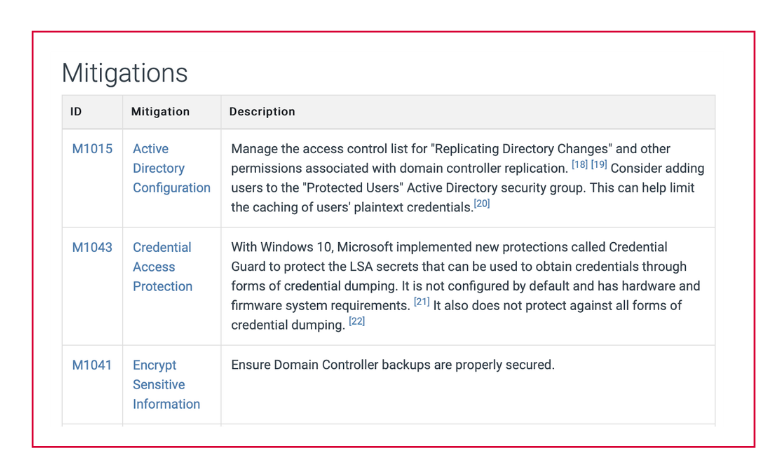
This section provides suggestions for common mitigations for the technique or sub-technique. As shown in the above image, some mitigation suggestions are very specific and easy to apply, but some are too generic. Currently, 43 different Mitigation measures are provided by MITRE ATT&CK for Enterprise.
2.3.6. Detection
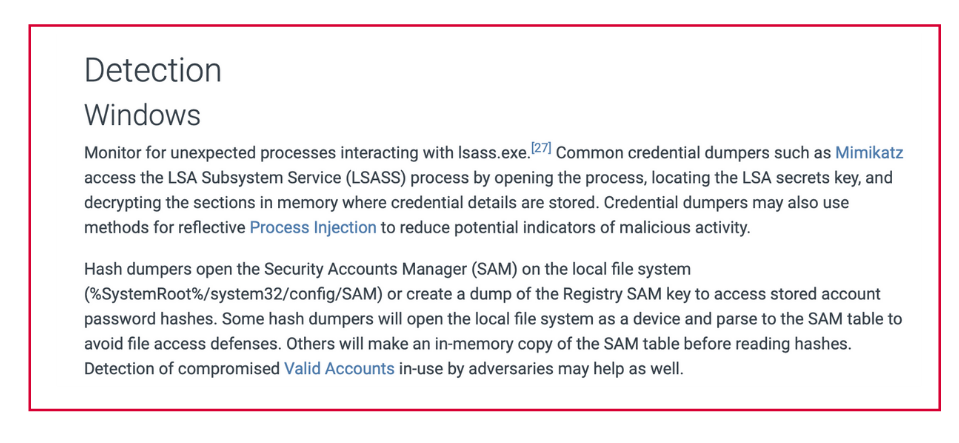
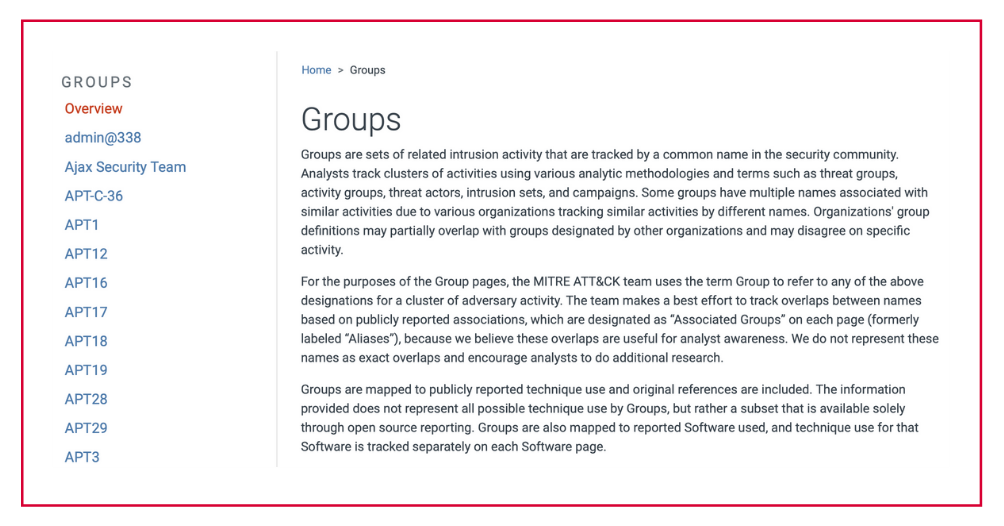
Groups are threat groups, activity groups, or threat actors related to an intrusion activity and are tracked by a common name in the security community. Currently, there are 133 groups in the MITRE ATT&CK Framework.

As seen in the screenshot, ATT&CK provides attribution of the group, targeted geographies, and targeted sectors. For example, the MuddyWater APT group is attributed to Iran, and it targets telecommunication, government, and oil companies in the Middle East, Europe, and North America.
Like other objects in the MITRE ATT&CK framework, each group has an ID. Moreover,ATT&CK also provides associated groups with the group, which are the same or very similar groups in threat intelligence reports.

For each threat group, MITRE ATT&CK includes techniques used by the group and briefly describes how the group used techniques. Furthermore,ATT&CK visualizes the techniques used by the group on the ATT&CK Navigator, as seen on the below image.

Aside from the ATT&CK techniques used by a threat group, the framework provides a list of Software used by the threat group, as shown in the below image. The software list for each threat group also includes the ATT&CK techniques used by the group.

4.Software
Software is categorized into malware and tools in the MITRE ATT&CK framework.
Malware: Commercial, custom closed source, or open-source software that is intended to be used for malicious purposes by adversaries falls under the malware category.
Tools: Commercial, open-source, built-in, or publicly available software that could be utilized by a defender, penetration tester, red teamer, or attacker is included in the tools category. Tools can be software that isn't typically found on an enterprise system, such as Mimikatz, Metasploit, and Empire. Moreover, tools can be commonly available as part of an operating system or can be already installed on a system, such as certutil, netstat, and bitsadmin, which are also referred to as “living-of-the-land” tools. Emerging threat actors, such as DarkSide ransomware group, heavily use these publicly available and living-of-the land tools.

Similar to Groups, software pages include not only techniques used by each software but also how threat groups utilize these techniques. Besides, these techniques are also visualized on the ATT&CK Navigator.
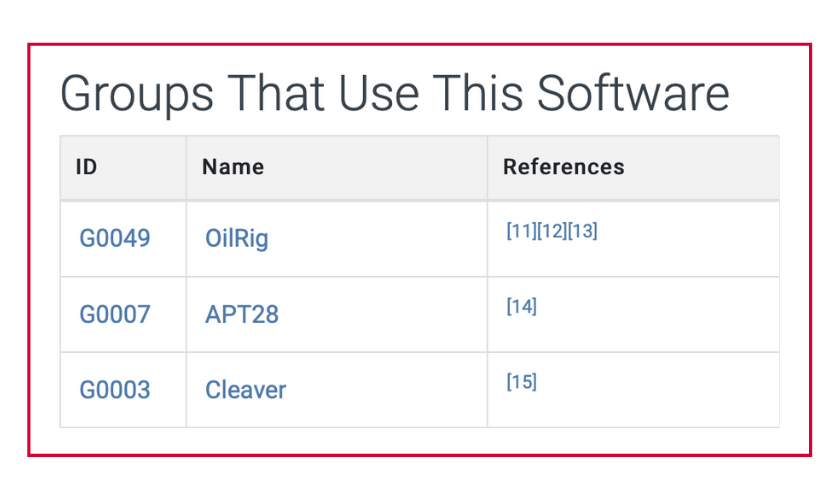
5.Operationalizing MITRE ATT&CK
The MITRE ATT&CK framework has become a common language between security teams. For example, threat Intelligence teams use MITRE ATT&CK to investigate techniques used by adversaries, red teams can use it for adversary emulation and security validation, blue teams utilize it to improve detection, and purple teams use MITRE for assessment and mitigation.
However, operationalizing MITRE ATT&CK requires skilled CTI, red, blue, and purple teams, as well as strong cooperation between these teams. To learn how to operationalize the MITRE ATT&CK framework, please enroll in our free "Operationalizing MITRE ATT&CK for SOCs" course in Purple Academy.
Top Ten MITRE ATT&CK Techniques
As a result of the comprehensive analysis of tens of thousands of real-world threat samples collected from numerous sources, Picus Labs unrevealed the most prevalent ATT&CK techniques and tactics to help you focus on what significantly improves your security.

APPENDIX A - Type of Indicators
The following table describes each indicator type according to the defender's and adversary's perspectives.
|
Indicator Type |
Defender’s Perspective |
Adversary’s Perspective |
|
Hash Values |
Reliable indicators because the likelihood of two separate files having the same hash value is negligible. SHA 256, SHA1, or other hash algorithms can be used to provide unique references to individual samples of malware involved in an intrusion. |
It is straightforward to change the hash value of a malicious file; for example, adding a null byte to the end will yield a different hash value. So, it is worthless to track hash values as there are so many of them, and adversaries can easily change them. |
|
IP Addresses |
IP addresses used by adversaries are fundamental indicators. For most cyberattacks, adversaries need to connect to the target network, which requires an IP address. |
Adversaries can change IP addresses very quickly and frequently by utilizing anonymous proxy services, the Tor network, botnets, and proxy chains. |
|
Domain Names |
Domain names used by Command and Control (C2) servers are helpful indicators to detect malicious activities within the network of an organization |
It is trivial to change domain addresses by utilizing DNS providers with lax registration requirements and dynamic DNS providers. Moreover, adversaries use domain generation algorithms (DGA) to generate many potential domain names for a malicious server, making it difficult to identify them. |
|
Network / Host Artifacts |
Network artifacts are pieces of the network activity that can help differentiate malicious network connections from legitimate ones. URI patterns, header values, and specific user-agent values are examples of network artifacts. Host artifacts are observables created by adversary behavior on target hosts, such as registry keys, dropped files, created directories, and services. |
When network or host artifacts of a cyberattack are identified, the adversary must go back to the weaponization phase of the cyber kill chain and change the configuration of their tools and recompile them. |
|
Tools |
Tools are software used by adversaries for malicious activities such as Mimikatz credential dumper, Cobalt Strike, Empire, or other host-based utilities used by adversaries. |
If a tool used in cyberattacks was identified, the adversary must go back to the weaponization phase of the cyber kill chain and find or create a new tool. A new tool requires research and development effort. |
|
TTPs (Tactics, Techniques and Procedures) |
TTPs are the most valuable indicators. TTPs reflect adversary behavior in all stages of a cyberattack, from reconnaissance through data exfiltration, e.g., dumping credentials from the LSASS memory. However, TTPs are also difficult to model and apply to security controls. |
When a TTP is identified, adversaries must find and implement a new behavior, which is the most time-consuming activity. Identifying, detecting, and responding to a TTP forces adversaries to change their behavior, requiring significant time and monetary investment. |